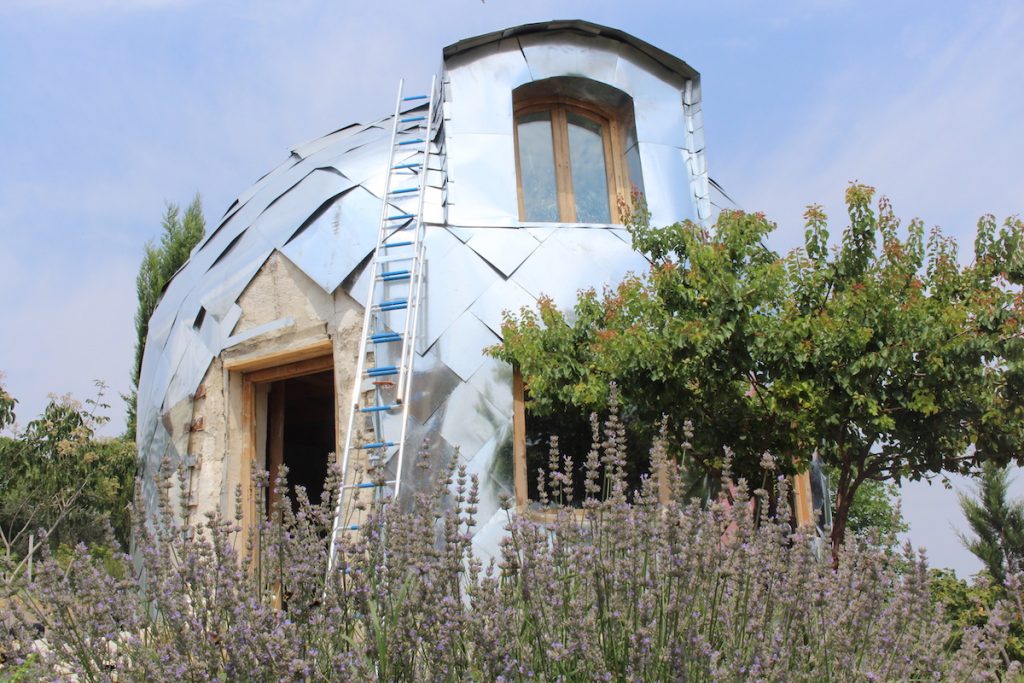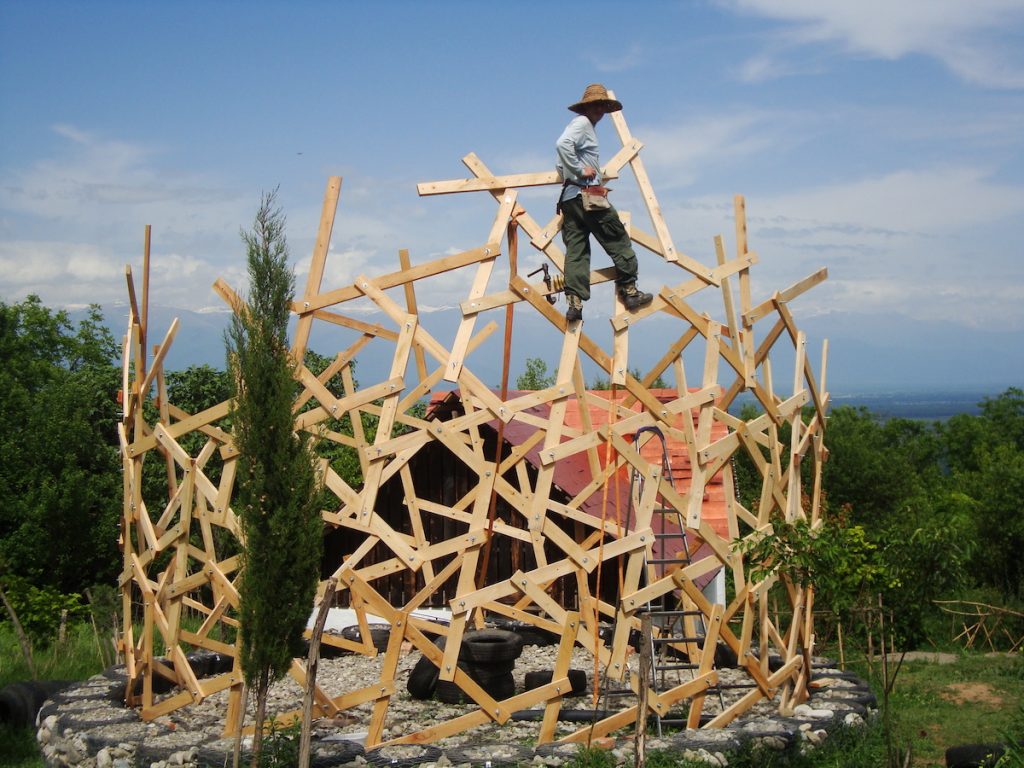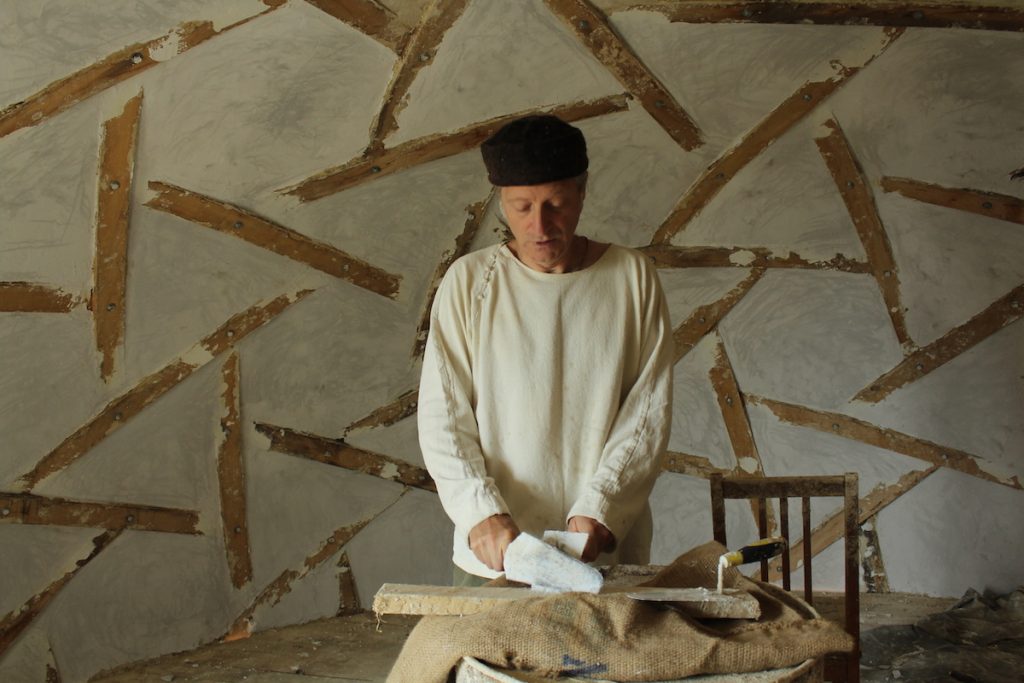Living in a house made of straw
When I leave this world, I want nothing to be left behind, says David Chachanidze, who lives in a house made of bales of straw.

Construction and demolition waste makes up approximately 30% of the landfill material the world over. If we don’t want landfills full of concrete, we need to think about ways to recycle such waste, or not to create it at all.
David Chachanidze is among the few in Georgia, who are dealing with this problem on a personal level. Together with his wife Tina Samadashvili, an architect, they’ve built three houses completely out of natural materials – mainly wood, lime, earth, and straw bales. Such a house, when deconstructed, decomposes in just one year.
The reason for building houses out of natural materials is not only environmental but also medical. As a doctor, David Chachanidze explains that living in a house such as his could solve health problems such as allergies or gastrointestinal issues.
Six years ago, life changed completely for David and his wife, as they moved from Tbilisi to Bakurtsikhe to live in the house they had built out of straw bales. “I think that when people become older, they need to put their feet down in the soil, not on concrete blocks in high rises”, Chachanidze opines.
This way of thinking combined with the Covid-19 pandemic led David to realize he does not need to live in the city. ”You can do business anywhere. I make cosmetics for skin from natural materials, I can sell it on the internet, I have consultations with my patients online, my wife also sells her furniture on the internet”, he explains.
Escaping the capital

Initially, the idea was to buy a house in the countryside, but none could satisfy their expectations: ecologically sustainable, good design, cool in the summer, and warm enough in the winter:
“All buildings were very strange – the old were destroyed and new were made out of low-quality materials such as concrete blocks or asbestos. The ground floor would be damp and full of mold, reeking of mushrooms while the upper floors were empty and drafty with no heating options. That’s why we decided to build a house ourselves and even spent four years researching, how people build eco-friendly homes all around the world”, says Chachanidze. According to him, it is synthetic materials that absorb humidity causing mold in many modern houses.
Finally, they bought a plot of land in Bakurtsikhe. It took one year and 6,000 GEL to build their first house. The couple decided on a house made out of straw bales because straw is very cheap and easy to get in Kakheti.
The construction is wood and the clay from their garden was also used, as well as eggs and milk for the plaster:
“This house can stay up for 700 years, like the Charles Bridge in Prague, where they also used eggs and milk in the plaster, but when deconstructed and left out in the sun and rain, it decomposes in a single year which I think is good. We arrived into a world of clean land, thus we should leave it clean when we are gone”.
Thanks to the 5 cm thick plaster and compressed straw, the house can’t burn down. “There is no oxygen inside the wall, and that is why it is safe,” explains Chachanidze. He and Tina are the first in Georgia to build a house out of straw bales for living:
“The first house was an experiment and we made many mistakes – for example using clay for plaster. All the information we learned from books, but clay in US is not the same as in Georgia and its plastering starts cracking. In the second house, we’ve decided to use lime from Rustavi and so far it’s working great,” proclaims David.
Inspired by Da Vinci

The second house became a real masterpiece. Designed in the shape of a hyperbola and covered in sheet metal for better insulation. The couple was inspired by Leonardo Da Vinci’s plans:
“It is organic architecture taken over from the sphere. We were going for something like a woman’s womb which is shaped like a sphere. It is an optimal structure for energy circulation, vital energy, and heat. Importantly the air remains cool even though it is hot outside. And in the winter, it will be warm inside, as straw is a great insulator”, Chachanidze says. Additional insulation comes from the ground below – 2,500 glass bottles were used to create the floor.

The home’s framing is made out of wooden triangles and hexagons, which allows the builder to create round shapes:
“Of course it was difficult to build because you need to know mathematics and geometry very well. It’s like a puzzle. My wife and I are a good team. She is an architect and I am like an idiot-savant, but in a good way, like Forrest Gump – when I started building those houses, I had no idea what I was doing.
I just did everything she told me to do because, as an architect, she could see the end result of the structure. I do the mechanical part and we are learning together. We had to disassemble everything five times before we could manage to get to the point where it looks how it does now”.
Many people come to David and Tina’s house to see their work. Some of them, mostly foreigners, stay and help David with the construction. Apart from the two inhabited houses, there is one more made out of earthen bags, which serves as a stable for Tina and David’s property. Another house is being built by his children just outside Tbilisi.
According to David Chachanidze, anyone who is interested could build such a house. “After us, there were at least three people building homes out of straw bales and maybe even better ones because they learned from our mistakes. There was one guy who came and let me shown him everything; he then said: ‘Ok, I understand, and went on to build a house himself”.
Assessing the pros and cons

There are many advantages to houses made out of straw. First, they are environmentally friendly. The straw itself is a waste material, as only the part, which can’t be eaten, is used. It is not too hard to plant straw and when it is left out in sun and rain, it can easily decompose itself.
Because straw is a great insulator, there is not that much energy needed to heat the house in winter and keep it cool in summer. As the walls are 30 cm thick, they make it harder for the sun to heat the house. The low cost of the materials is also very tempting. Though, there are also some disadvantages.
As the walls need to be quite thick, the same size brick house would be more spacious inside. Using straw as a construction material is also not recommended in a high humidity environment, as the straw, once wet, might never dry again.
This could lead to mold and if not dealt with, even collapse. For David Chachanidze, humidity is not a threat. As he built the house in Kakheti, he must deal with the opposite problem:
“We’ve built a long piping system, which provides us with some water from the forest nearby. That is enough for washing, but still, there is very little during the summer and the water is not potable. We need to buy clean water and the only way is to buy it in big plastic bottles. As we try to be conscious about plastic waste, we then use the bottles as flower pots”.
In the future, David wishes to become completely self-sufficient. As soon as he finishes the second house, he plans to put all his efforts into the fruit and vegetable garden, to provide fresh, organic food for his family. As he is also working as a homeopathic doctor, he does not ask his patients for money, but they bring him eggs, milk, or other homemade products.
The idea for the future is to start a business with honey bees. “We want to make use of the space around our house and teach people how to care for bees”. According to David, for older people, working the fields is very difficult but working with bees is manageable. Additionally, bee products are also very good for the elderly:
“We really want to take care of the bees and plant trees to create an ecosystem that is suitable for this place – for people, animals, and the environment”.


















